 We knew getting through the dirt roads of Northern
Kenya was going to be hard. There has already been a few challenging off road stretches on this trip.Driving from Wadi Haifi to Dongola in Northern
Sudan and relying solely on the GPS to carve the road out of the
desert was an exercise in trust. Scraping
up mountain trails, choking on a diet of lorry dust was an unexpected ‘Welcome to Ethiopia’.
We knew getting through the dirt roads of Northern
Kenya was going to be hard. There has already been a few challenging off road stretches on this trip.Driving from Wadi Haifi to Dongola in Northern
Sudan and relying solely on the GPS to carve the road out of the
desert was an exercise in trust. Scraping
up mountain trails, choking on a diet of lorry dust was an unexpected ‘Welcome to Ethiopia’.
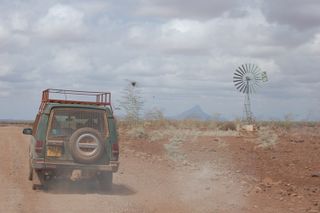
However, we always knew the 300 mile stretch between Moyale
and Isiolio would be make or break. We
knew the dirt road would be abysmal but precisely how bad had been the subject
of much debate amongst southbound overlanders in Addis Ababa. The morbid speculation about the
jagged rockroads and relentless corrugations didn’t help and only aggravated
the blister of apprehension. We chose to put speculation aside and rather focus
on hitting unbroken tarmac in Isiola and free-wheeling the rest of the way
through Southern Africa.
Arriving at the Ethiopia/Kenya border we encountered a
couple of South Africans, driving a resilient looking Defender, a veritable mudbull.
They were pumped, looking bewildered and deranged with adrenalin. We narrowly avoided some furious
chest-bombing.
Nervously we told them we were heading to Isiola. Their
initial reaction betrayed them. Wide eyed: ‘Sh*t bru, that sh*t was crazy,
those roads are seriously insane’. Sensing our trepidation, and perhaps a
sudden noxious smell, they composed themselves, reassuring us that we would be
alright providing we ‘gunned those corrugations’. They then told us the journey
cost their mudbull its steering bushes (car shrubbery?). The fact that even
their brickmobile had stumbled was silently digested. We departed with a
heartfelt ‘Good luck’.
A bit of background now, in 1960’s the Kenyan’s and the
Ethiopians signed a treaty to build a tarmac road between Addis and Nairobi. The project would
create a platform for increased trade between these two massive centres of industry
and commerce in East Africa.
Whereas the
Ethiopian’s took this treaty as a literal agreement and built an actual asphalt
road to the border, the Kenyan’s clearly interpreted it more creatively, more
as a statement of intent than a real world obligation. Now, nearly 50 years later only the intention
of a real road remains, unfortunately the road to hell is clearly paved with
such good intentions. The analogy is
appropriate.
The journey was broken into 2 legs punctuated by a stop in
Marsabit, which I have already written about. Heading into the journey the cars
were in relatively good nick, well, relative to how they emerged. Only Jane’s brakes needed looking at. The old
dame suffering from worn joints and was constantly leaking. It was a minor
embarrassment and we opted to keep her topped up with brake fluid rather than
draw attention and cause offense unduly.
We tested the roads from the border for a couple of hours
before bad light prevailed and we set up bush camp. This first stretch was
regarded as the acceptable part of this road, before things got really
tough. In 2hrs we had travelled an
acceptable 35km.
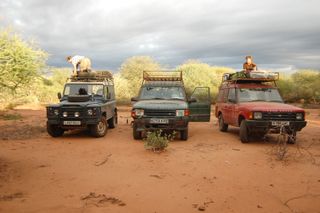
Bush camp, proper African bush camp was real. We made our
first fire, in which we disposed of our food waste and thereby ensure we didn’t
attract any attention from baboons, lions or werewolves that roam Kenya at night. At one stage a herd of cattle
wandered through the camp whilst we were sat around discussing the day’s
events. Probably escaping the
werewolves. So real.
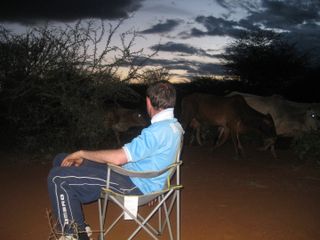
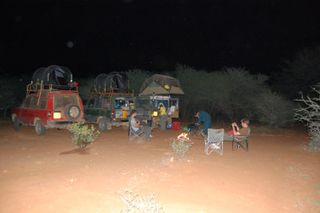
Anyway, we set off the next day early, composed and
determined. For at least an hour, before we got a flat tyre. Not a catastrophe,
the tyre was balder than a …… well, it was proper bald. This did ensure we got
dirty however, the earth, a bloody orange, copper colour now painted on our
clothes.
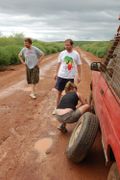
Despite only managing a top speed of 15km p/h nothing
further went wrong mechanically on that day. In hindsight it was merely a
brutal form of foreplay for the second leg. The going was arduous because the
roads were based on rocks scraped together.
They were small vicious, jagged rocks. Rasping at our tyres like coral
menaces bare flesh. The simultaneous grinding of tyres and teeth as we prayed
the vehicles were up to it.
We were driving through desert, but coated in billions upon
billions of black boulders, as though God herself had seasoned the terrain with
a giant bouldermill. And it was lonely. We passed 4 cars in nearly 10 hours of
driving. We got the idea. No one used this road. Crunch, crunch, crunch and it
went on and on. Bemused eagles watched the micro machines battle the rice
crispies from above.
Eventually we arrived in Marsabit, only slightly tarnished
by the journey with a residual rocky road sickness similar to the phantom
swaying you get after you get off a boat. But we had negotiated the worst road and drew
encouragement from this.
Marsabitian’s had
told us only a few mere corrugations separated us from the freedom of tarmac,
from glory. It was with a false sense
confidence therefore that we embarked on the final stretch to Isiola. In our minds
the war would be over by Christmas.
In what was the
hardest going of this whole trip the next 12 hours smashed and rattled our poor
vehicles in ways that were borderline perverse.
Relentless bumping. Corrugations,
we learnt, are the driving equivalent of leprosy, slowly eating away at the
vehicles core constitution till parts just start dropping off. Our vehicles that had negotiated a lot of punishment
in the two months just lost their fire.


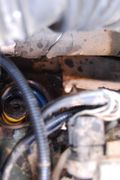
First to go was Jane, whose front right damper ripped off
causing the shock absorber piston to smash up past the filter right into the
bonnet. To the rhythm of bang, bang,
bang, BANG BANG, we soldiered on until we realised that the piston was actually
dislodging the suspension coil. Neil,
one part of our welsh tour party and a Football Africa roadie had a lot of
experience working on Landies and was the crucial voice of calm as he diagnosed
how to rectify the situation. Using his high lift jack the damper was removed
the shock absorber pistons and the coil was realigned to ensure we had some
suspension if not the means to counteract the bouncing. This was the first of
the four shock absorbers we lost.
We have come to expect Lady Jane to be a liability but when
Robin started acting up we really started to lose confidence. We had to perform
the same operation on Robin 4 hours later, removing the damper but this time
the suspension coil just shot out and tangled up with our brake cables impeding
any further progress. It looked like the moment we were all dreading had
arrived. We were going to have to leave Robin (a complete surprise) on the side
of the road and progress in Jane. It was unthinkable.
Fortunately we managed to untangle the suspension coil with
much fannyaroundmentation, thereby resting the left side of Robin on the thin
bit of rubber between the chassis and the rest of the body.

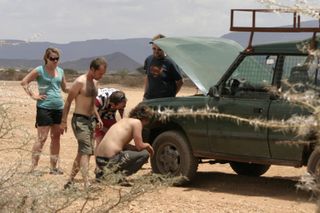
Robin had effectively had a stroke. We could drive but we
were in dire straits. Then Janes battery started to play up. Over reliance on the chiller meant she
couldn’t even muster the charge to power the lights. Now the sun was setting, we had only driven
110km in 10 hours, we were in bandit country (oh year and that, which almost
seemed irrelevant) had one car with no battery (we had to stop and jump start
her every 20 mins), no front suspension on either vehicle and no end in sight.
It was grim, we were making roughly 10kms to the hour on absolute tenterhooks. In
pitch black Andy was driving Jane with no lights on using Neil’s tail lights as
the only guide. It was horrible.
Through sheer denial of the reality of the situation we
managed to drive in the dark and scrape into a restspot called Archers post. It
took us two hours of night driving to get there. Everyone was mentally shattered, some physically
wounded. Poisonous thoughts were being posted about the Kenyan Govt. We were
all thinking the same thing, they had 50 flippin’ years to get this road built.
Anyway I have been writing this for too long now. Long story short is we barely made it, but we
made it. It was truly heroic. Special shout out to Welsh Neil and his calm
farmer’s head.

When we finally arrived in Nairobi and the sanctuary of an overlander
campsite Jungle Junction the owner, Chris, congratulated us and remarked that
the North Kenyan road is the ‘difference between boys and men. That is where
you earn your man points.’ Rugger.
Ed
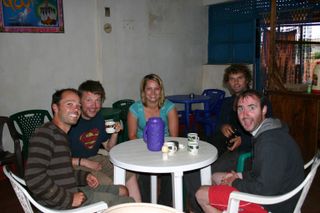
This was our first opportunity to visit one of
Tackle Africa’s partners since we arrived on the continent. It is important to
us that we capture as much footage of the work Tackle Africa (www.tackleafrica.org) is doing as
possible as they have been huge supporters of what we’re doing here. So it was
great relief that we met Daniel Falau of the Simba Maasai Outreach Organisation
in Nairobi who arranged for us to go and see how Tackle Africa’s coaching
manual was helping to educate a local community (Oloshoibor) about HIV outside
Nairobi.